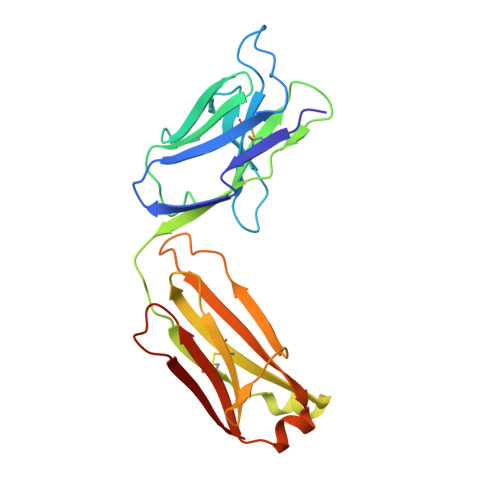Sculpting a Uniquely Reactive Cysteine Residue for Site-Specific Antibody Conjugation.
Hwang, D., Nilchan, N., Park, H., Roy, R.N., Roush, W.R., Rader, C.(2022) Bioconjug Chem 33: 1192-1200
- PubMed: 35584359
- DOI: https://doi.org/10.1021/acs.bioconjchem.2c00146
- Primary Citation of Related Structures:
7TUS - PubMed Abstract:
Catalytic antibody 38C2 and its humanized version h38C2 harbor a uniquely reactive lysine at the bottom of a 11 Å deep pocket that permits site-specific conjugation of β-diketone-, β-lactam-, and heteroaryl methylsulfonyl-functionalized small and large molecules. Various dual variable domain formats pair a tumor-targeting antibody with h38C2 to enable precise, fast, and stable assembly of antibody-drug conjugates (ADCs). Here, we expand the scope of this ADC assembly strategy by mutating h38C2's reactive lysine to a cysteine. X-ray crystallography of this point mutant, h38C2_K99C, confirmed a deeply buried unpaired cysteine. Probing h38C2_K99C with maleimide, monobromomaleimide, and dibromomaleimide derivatives of a fluorophore revealed highly disparate conjugation efficiencies and stabilities. Dibromomaleimide emerged as a suitable electrophile for the precise, fast, efficient, and stable assembly of ADCs with the h38C2_K99C module. Mass spectrometry indicated the presence of a thio-monobromomaleimide linkage which was further supported by in silico docking studies. Using a dibromomaleimide derivative of the highly potent tubulin polymerization inhibitor monomethyl auristatin F, h38C2_K99C-based ADCs were found to be as potent as h38C2-based ADCs and afford a new assembly route for ADCs with single and dual payloads.
- Department of Immunology and Microbiology, The Scripps Research Institute, Jupiter, Florida 33458, United States.
Organizational Affiliation:




















